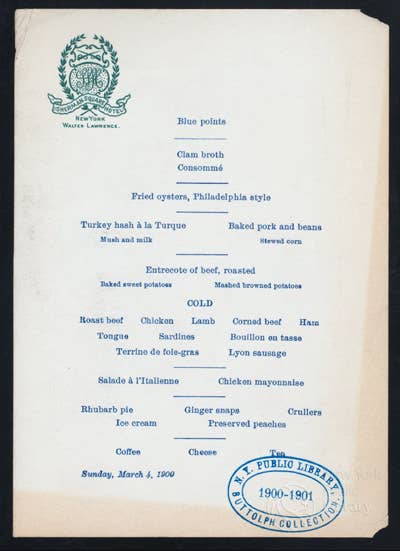
Dining Commons: The New York Public Library’s Ambitious Menu Database Project
The New York Public Library (NYPL) had a problem to solve—they had a marvelous collection of 10,000 digitized menus from as far back as the 1850s, but no way to search the menus' contents. If readers wanted to figure out how popular pickled lambs' tongues were in 1900, their only recourse was to physically read through the menus from that year.
That's when the NYPL's Rebecca Federman, Culinary Collections and Electronic Resources Librarian, and Ben Vershbow, Manager of NYPL Labs turned to the public for help. Their new website, What's On The Menu? (menus.nypl.org), asks readers to help transcribe all of the dishes on each menu. The project had two main objectives: to build a data set from the menu collection in an inexpensive way and to raise awareness of the Library's incredible collections of historical materials. "We can't afford to have these treasures kept solely under lock and key, accessible only to the most determined researchers," says Vershbow.
Volunteer data clerks can choose a digitized menu from the collection, click on any dish, and type its name into the form field. Each dish name becomes a "tag"; click on an individual dish tag and you get a page with all of the menus that have been tagged as having that dish. This kind of hive mind project has a number of precedents, from Wikipedia's crowdsourced encyclopedia to the Guardian's quest to vet over 450,000 pages of the expense documents of the members of the British Parliament.
Part of the joy of being a contributor to the project is perusing artifacts that tell a story of another era. Each menu is like a snapshot of a specific time and place; it's fun to wonder what "cold pineapple cream" might have been like at Mangler's in Chicago, IL at the turn of the century, or to see that dandelion was in vogue in the D&H Dining Car Service in May of 1900. What's On The Menu? is still in beta; it features only a portion of the Library's digitized menus and none of the 30,000 physical menus which have not yet been digitized. Barely a week into the project and over 56,000 dishes have already been recorded for more than 700 menus. Vershbow and Federman hope that the same public who are helping to transcribe this project will also find ways to use the data—from chefs researching vintage dishes to revive to food bloggers looking for inspiration for what to cook for dinner.
As keeper of the collection, Federman unearths patterns and discoveries which she plans to blog about. "I'd like to explore dishes that have remained popular over time, but also talk about dishes that never see the light of day today," she says.
Data entry is just phase one of this ambitious project. The next steps will involve manual semantic enhancements necessary to tie dishes like "clear green turtle" and "tomato aux croutons" together as soups. "We also might explore different categories (of restaurant or of dish) for browsing and searching, and perhaps eventually geographic and price-based exploration tools," says Vershbow. "In other words, we're just getting started."
Keep Reading
Continue to Next Story










